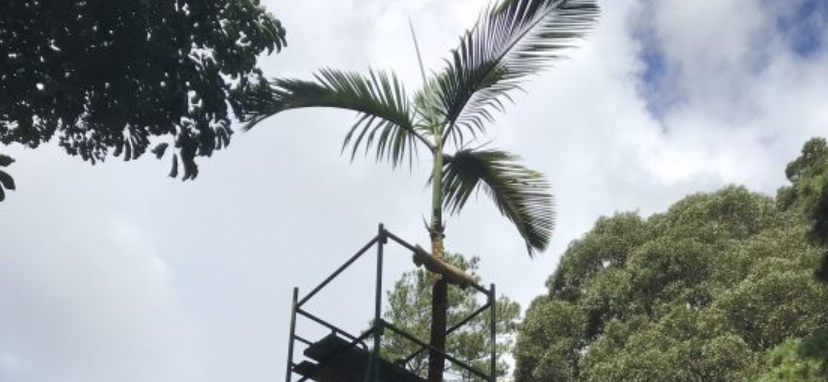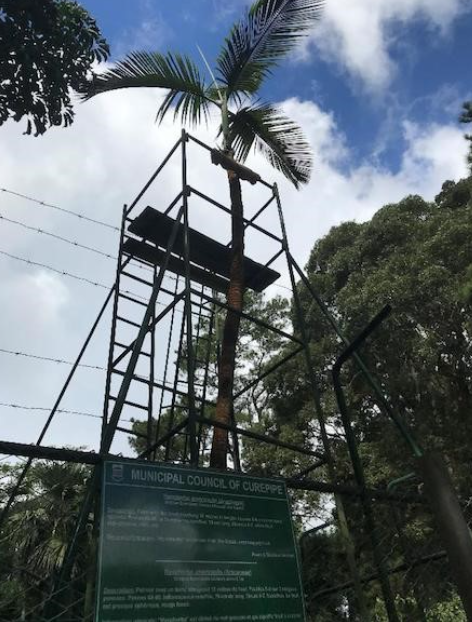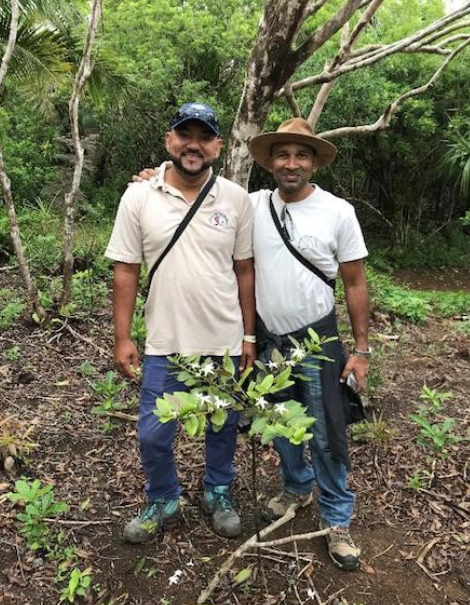The loneliest tree in the world
-
Country
Mauritius -
Region
Africa -
Programme
BGCI's Tree Conservation Programme -
Workstream
Saving Plants -
Topic
Tree Conservation -
Type
Blog -
Source
BGCI
News published: 19 August 2019
Standing and watching the loneliest tree in the world, my first reaction was one of sadness – that with all of humankind’s collective knowledge and ingenuity, we haven’t been able to propagate this plant.

Hyophorbe amaricaulis has lived in the Curepipe Botanical Garden in Mauritius for the past 150 years or so. Today, it is enclosed by a kind of cage and supporting platform, and is looking old and tired. It has damage to its trunk, and signs of a bacterial infection in the wound. Its leaves droop as if it is tired of life and living alone.

Working in botanic gardens, we assume that there is no technical reason why any plant species should become extinct. With the array of horticultural techniques at our disposal, if we can get to plants in time and if we can deploy our collective knowledge and skills, we should be able to propagate a threatened plant. For the thousands of plant species that have dwindled to a few individuals in the wild, that have nobody watching out for them, it is a different story. But this one is in a botanic garden (albeit probably originated there as a wild species before the garden was established). We should be able to save it.
There is hope
The purpose of my visit to Mauritius and Rodrigues is to establish a Global Trees Campaign conservation programme aimed specifically at trees that are critically endangered and reduced to a handful of individuals, like the Loneliest Palm. Like most oceanic islands, Mauritius has more than its fair share of such species. Thanks to their evolutionary isolation, the endemic plants of Mauritius and Rodrigues have little defence against invasive species such as rats, mongooses, monkeys, deer and pigs. The clearing of large swathes of native vegetation for sugarcane plantations in the 18th and 19th centuries also destroyed vast numbers of indigenous species. Perhaps most insidious of all, invasive plants such as the Traveller’s palm (Ravenala madagascariensis) and the Chinese guava (Psidium cattleyanum) are outcompeting native plant species, the latter forming dense thickets, and enthusiastically spread by local residents who love its fruits.
But there is hope. If you were to take the Red List of Threatened Plant Species for Mauritius and Rodrigues of 20 years ago, you would assume that there were more than 50 tree and shrub species on these islands that are down to a handful of individuals. Today, the situation is quite different. Thanks to organisations like the Mauritian Wildlife Foundation, the Mauritian National Parks & Conservation Service, the Forestry Service and private enterprises such as Ebony Forest, most of these species are being propagated and many have been reintroduced into the wild in forest restoration programmes.
Nowhere is this more true than in Rodrigues, where the sole surviving Café Marron (Ramosmania rodriguesi) was discovered by a schoolboy in 1979. Today, the original is still there (in a cage) but thanks to the efforts of specialist horticulturists at Kew and on Rodrigues itself, it has been reintroduced back into the wild in the Grande Montagne Reserve, and I saw third generations of this plant flowering and producing seed in a Forestry Service nursery.

“We need to match the right skills with the right plants.”
– Paul Smith
Despite the successful work that has been carried out on the Café marron and a wide range of other endemic species on these two islands, there are still a few species that defy attempts to propagate or establish them outside nurseries. On Rodrigues these include Zanthoxylum paniculatum (only two left), Badula balfouriana and Dombeya rodriguesiana. Reflecting on these species, and the Loneliest Palm back on Mauritius, it seems to me that we need to match the right skills with the right plants.
BGCI’s GardenSearch directory of the world’s botanic gardens lists over 3,000 botanical institutions in nearly every country in the world. In those gardens we estimate that there are upwards of 60,000 specialist horticulturists and plant scientists. Surely in that network we can find the palm grower we need or the seed specialist for Rutaceae or Rhamnaceae.
Plant Doctors
The mechanism for deploying this expertise? Perhaps something like Medecins Sans Frontieres or Gorilla Doctors, where institutions dispatch their ‘Plant Doctors’ (and I don’t mean people with PhDs) around the world to save species before it is too late. In fact, this has been happening through the Global Trees Campaign and other conservation initiatives for many years in an ad hoc way but now we really need to get more organised. We also need to acknowledge and prepare for the fact that developing the right protocols can take years of sustained effort.
BGCI has a list of around 500 critically endangered tree species that are down to a few individuals. Now it is time to match the tree with the expert! BGCI is compiling a directory of conservation horticulture expertise that will be used for this purpose. If you or your institution has specialist horticultural expertise and you would like to deploy those skills where they are most needed, please contact us.
Written by Paul Smith. Dr Paul Smith is the Secretary general (CEO) of Botanic Gardens Conservation International, which leads the Global Trees Campaign with FFI. Dr Smith is a plant ecologist who specialises in the flora of south-central Africa. His publications include two tree field guides, the Vegetation Atlas of Madagascar and the Ecological Survey of Zambia.
Calling all Experts
As a membership benefit exclusively for BGCI Institutional Members, staff associated with these institutions can apply for inclusion in BGCI's Directory of Expertise.
Support BGCI
You can support our plant conservation efforts by sponsoring membership for small botanic gardens, contributing to the Global Botanic Garden Fund, and more!